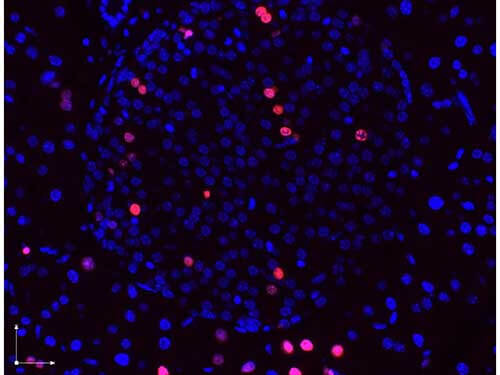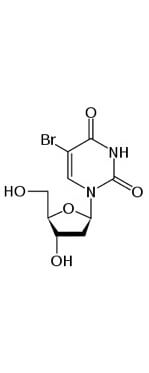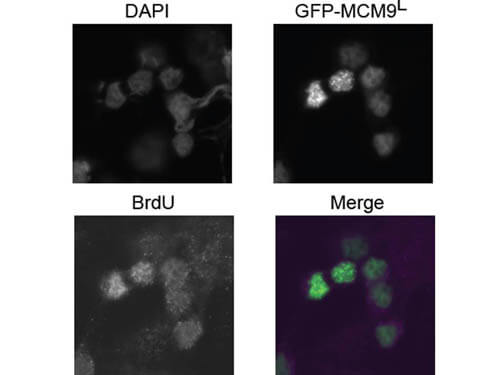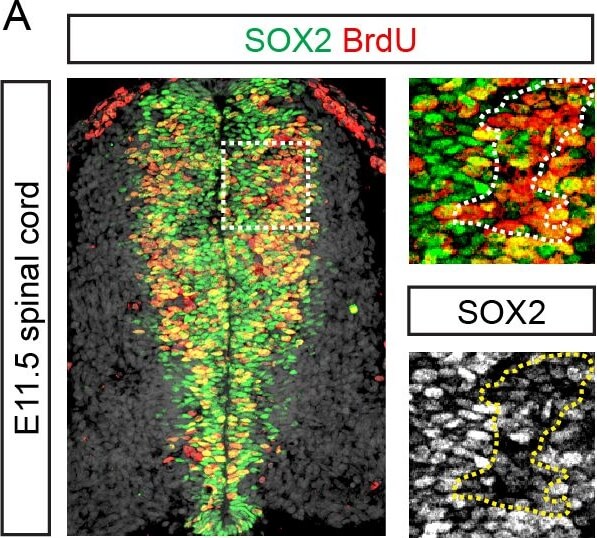Datasheet is currently unavailable. Try again or CONTACT US
BrdU Antibody
Rabbit Polyclonal
27 References
600-401-C29S
600-401-C29
25 µL
100 µg
Liquid (sterile filtered)
Liquid (sterile filtered)
WB, ELISA, IHC, IF, FC, IP, Multiplex, Other
BrdU
Rabbit
Shipping info:
$50.00 to US & $70.00 to Canada for most products. Final costs are calculated at checkout.
Product Details
Anti-BrdU (RABBIT) Antibody - 600-401-C29
rabbit anti-BrdU Antibody, bromodeoxyuridine, 5-bromo-2'-deoxyuridine
Rabbit
Polyclonal
IgG
Target Details
BrdU
Other
Anti-BrdU affinity purified antibody was purified from monospecific rabbit antiserum prepared via repeated immunizations with BromodeoxyUridine-KLH.
Anti-BrdU Antibody was affinity purified from monospecific antiserum by immunoaffinity chromatography.
Application Details
ELISA, IHC, WB
FC, IF, IP, Other, Multiplex
- View References
Anti-BrdU Antibody has been tested by ELISA, WB, IHC, and is suitable for immunofluorescence microscopy and flow cytometry. Specific conditions for reactivity should be optimized by the end user. Expect to detect incorporated BrdU thymidine analog from replicated cells.
Formulation
1.23 mg/mL by UV absorbance at 280 nm
0.02 M Potassium Phosphate, 0.15 M Sodium Chloride, pH 7.2
0.01% (w/v) Sodium Azide
None
Shipping & Handling
Dry Ice
Store BrdU Antibody at -20° C prior to opening. Aliquot contents and freeze at -20° C or below for extended storage. Avoid cycles of freezing and thawing. Centrifuge product if not completely clear after standing at room temperature. This product is stable for several weeks at 4° C as an undiluted liquid. Dilute only prior to immediate use.
Expiration date is one (1) year from date of receipt.
Bromodeoxyuridine (5-bromo-2'-deoxyuridine, BrdU) is a synthetic thymidine nucleoside analog. BrdU is commonly used to allow the detection of growing or proliferating cells in living tissues. During the S-phase of cell division, DNA replication occurs, and BrdU can be incorporated into the newly synthesized DNA by substituting for naturally occurring thymidine. Antibodies specific for BrdU are subsequently used to detect the incorporated BrdU thymidine analog. This highlights cells that were actively replicating their DNA and is suggestive of actively growing cells. Antibody binding usually requires the DNA to be denatured, typically by exposing the cells to acid or heat.
Pradhan SK et al. (2024). Developmental Changes in Genome Replication Progression in Pluripotent versus Differentiated Human Cells. Genes (Basel).
Applications
IF, Confocal Microscopy
Ning K et al. (2023). Identification of AXL as a co-receptor for human parvovirus B19 infection of human erythroid progenitors. Sci Adv.
Applications
Cell Proliferation Assay
Sasaki L et al. (2022). Intracrine activity involving NAD-dependent circadian steroidogenic activity governs age-associated meibomian gland dysfunction. Nat Aging.
Applications
IHC, ICC, Histology
Iskusnykh, IY et al. (2021). Intrauterine growth restriction compromises cerebellar development by affecting radial migration of granule cells via the JamC/Pard3a molecular pathway. Experimental Neurology
Applications
IHC, ICC, Histology
Li D et al. (2021). IFI16 Isoforms with Cytoplasmic and Nuclear Locations Play Differential Roles in Recognizing Invaded DNA Viruses. J Immunol.
Applications
Proximity Ligation Assay (PLA)
Kint S et al. (2021). Single cell epigenetic visualization assay. Nucleic Acids Res.
Applications
IF, Confocal Microscopy
Kim HK et al. (2020). Notch Signaling Controls Oligodendrocyte Regeneration in the Injured Telencephalon of Adult Zebrafish. Exp Neurobiol.
Applications
IHC, ICC, Histology
Liu B et al. (2020). An inducible circular RNA circKcnt2 inhibits ILC3 activation to facilitate colitis resolution. Nat Commun.
Applications
IP, Co-IP; Other; RNA seq, qPCR, Reverse Transcription, RT-PCR Analysis
Horiguchi, K et al. (2020). Expression and functions of cluster of differentiation 9 and 81 in rat mammary epithelial cells. The Journal of Reproduction and Development
Applications
IHC, ICC, Histology
Sheng C et al. (2019). PCNA-mediated degradation of p21 coordinates the DNA damage response and cell cycle regulation in individual cells. Cell Rep.
Applications
IF, Confocal Microscopy
Velichko AK et al. (2019). Hypoosmotic stress induces R loop formation in nucleoli and ATR/ATM-dependent silencing of nucleolar transcription. Nucleic Acids Res.
Applications
IF, Confocal Microscopy
Roy A et al. (2019). IFI16, a nuclear innate immune DNA sensor, mediates epigenetic silencing of herpesvirus genomes by its association with H3K9 methyltransferases SUV39H1 and GLP. Elife
Applications
Other
Chizhikov VV et al. (2019). Early dorsomedial tissue interactions regulate gyrification of distal neocortex. Nat Commun.
Applications
IHC, ICC, Histology
Hagey et al. (2018). SOX2 regulates common and specific stem cell features in the CNS and endoderm derived organs. PLOS Genetics
Applications
IF, Confocal Microscopy; Multiplex Assay
Sarmento et al. (2018). Exploiting the tunability of stimulated emission depletion microscopy for super-resolution imaging of nuclear structures. Nature Communications
Applications
WB, IB, PCA
Ganaie et al. (2018). RNA Binding Protein RBM38 Regulates Expression of the 11-Kilodalton Protein of Parvovirus B19, Which Facilitates Viral DNA Replication. Journal of Virology
Applications
WB, IB, PCA
Parisotto et al. (2018). PTEN deletion in luminal cells of mature prostate induces replication stress and senescence in vivo. Journal of Experimental Medicine
Applications
IHC, ICC, Histology
Xu et al. (2017). Parvovirus B19 NS1 protein induces cell cycle arrest at G2-phase by activating the ATR-CDC25C-CDK1 pathway. PLOS Pathogens
Applications
FC, FACS, FLOW
Xu et al. (2017). WNT10A mutation causes ectodermal dysplasia by impairing progenitor cell proliferation and KLF4-mediated differentiation. Nature Communications
Applications
IF, Confocal Microscopy; IHC, ICC, Histology
Narayan RS et al. (2017). Identification of MEK162 as a radiosensitizer for the treatment of glioblastoma. Mol Cancer Ther.
Applications
FC, FACS, FLOW
Shen et al. (2016). Analysis of cis and trans Requirements for DNA Replication at the Right-End Hairpin of the Human Bocavirus 1 Genome. Journal of Virology
Applications
IF, Confocal Microscopy
Shin et al. (2016). Vegfa signals through ERK to promote angiogenesis, but not artery differentiation. Development
Applications
IF, Confocal Microscopy
Luzhin AV et al. (2016). Automated Analysis of Cell Cycle Phase‐Specific DNA Damage Reveals Phase‐Specific Differences in Cell Sensitivity to Etoposide. J Cell Biochem.
Applications
IF, Confocal Microscopy
Velichko et al. (2015). Mechanism of heat stress-induced cellular senescence elucidates the exclusive vulnerability of early S-phase cells to mild genotoxic stress. Nucleic Acids Research
Applications
IF, Confocal Microscopy
Zhang, J et al. (2015). The transcriptional coactivator Taz regulates proximodistal patterning of the pronephric tubule in zebrafish. Mechanisms of Development
Applications
IF, Confocal Microscopy
Ansari, MA et al. (2015). Herpesvirus Genome Recognition Induced Acetylation of Nuclear IFI16 Is Essential for Its Cytoplasmic Translocation, Inflammasome and IFN-β Responses. PloS Pathogens
Applications
IF, Confocal Microscopy
Tulina NM et al. (2014). Day–night cycles and the sleep-promoting factor, Sleepless, affect stem cell activity in the Drosophila testis. Proc Natl Acad Sci USA
Applications
IF, Confocal Microscopy
This product is for research use only and is not intended for therapeutic or diagnostic applications. Please contact a technical service representative for more information. All products of animal origin manufactured by Rockland Immunochemicals are derived from starting materials of North American origin. Collection was performed in United States Department of Agriculture (USDA) inspected facilities and all materials have been inspected and certified to be free of disease and suitable for exportation. All properties listed are typical characteristics and are not specifications. All suggestions and data are offered in good faith but without guarantee as conditions and methods of use of our products are beyond our control. All claims must be made within 30 days following the date of delivery. The prospective user must determine the suitability of our materials before adopting them on a commercial scale. Suggested uses of our products are not recommendations to use our products in violation of any patent or as a license under any patent of Rockland Immunochemicals, Inc. If you require a commercial license to use this material and do not have one, then return this material, unopened to: Rockland Inc., P.O. BOX 5199, Limerick, Pennsylvania, USA.




